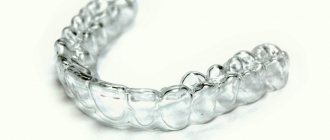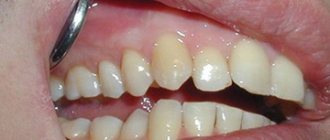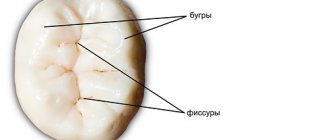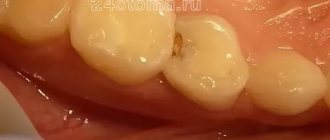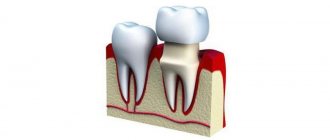Wearing braces is an effective method of correcting the bite, which allows you to correct the position of teeth in adolescents and adults. The period of wearing an orthodontic device is determined individually, taking into account the type of dental anomaly and can range from 6 months to 3-4 years. In order for the treatment to be successful, before it begins, you need to sanitize the oral cavity, cure the teeth and strengthen the enamel.
To get the desired result, many people have to wear braces for several years. During this time, the condition of your teeth may worsen. The risk of caries and pulpitis is higher in patients undergoing orthodontic treatment in adulthood. In some cases, after removing the braces, microprosthetics may be required. Find out why this need arises and how installing a crown after braces will affect the result of bite correction.
Indications for covering a tooth with a crown
Violation of the integrity of the crown part of the tooth
A tooth destroyed as a result of caries or injury can be restored with heliocomposite fillings, inlays and crowns. The choice of method depends on the degree of tooth decay. If there is a significant defect in the coronal part of the tooth, none of the methods can be used until the tooth stump is restored. To restore it, intra-root tabs or pins are used.
Pulpless tooth
A tooth that has previously undergone endodontic treatment becomes brittle over time and changes color, acquiring a gray tint. To prevent the destruction of such teeth and the appearance of aesthetic defects, it is recommended to cover them with crowns.
Severe tooth deformation
The loss of one or more teeth causes changes in the position of the remaining teeth. This is called dentofacial deformation. Before restoring the integrity of the dentition, it is necessary to first eliminate the deformation, which is expressed in the tilting or protrusion of adjacent teeth towards the defect. This can be achieved with the help of orthodontic treatment, or by making crowns for tilted teeth, having previously “grinded” them at the required angle.
Characteristic disadvantages of orthodontic crowns
The obvious disadvantages associated with fixing braces with metal rings include two factors:
- The complexity of the procedure, which takes a lot of time and effort, and requires effort from both the dentist and the patient;
- Formation of interdental gaps (three) after the rings are removed from the aligned elements of the dentition.
The invention of modern composite compositions, which guarantee high adhesion strength to the surface even with a minimal base area, has made it possible to get rid of such shortcomings. Today, all types of braces are fixed with orthodontic cement, however, when adjusting the chewing units, the use of ring fastenings is still allowed.
Different types of dental crowns
Stamped crowns
An outdated treatment method that is not used today. In the 90s in Russia, such crowns were very common, especially with “gold” coating (titanium nitride). It has now been proven that the material used for these structures causes an allergic reaction. Moreover, to create such crowns, a rather soft alloy was used, which quickly wore off with the formation of perforations in the crown. However, many people still have similar structures in their mouths, which it makes sense to replace with safer and more modern designs.
Solid crowns
Made from cobalt-chrome or nickel-chrome alloy. Because of the “metallic color”, such crowns are used only on chewing teeth that are not visible when smiling.
Metal-ceramic crowns
Classic version of prosthetics. They are a metal frame based on an alloy of noble or base metals, which is covered with a layer of ceramics on top. The result is a very durable and aesthetic structure that is indistinguishable in appearance and feel from natural teeth.
Metal-free ceramic crowns
A modern version of prosthetics. They look better than metal-ceramic crowns due to the fact that the frame does not have the “metal color”. The materials for the frame are lithium disilicate or zirconium dioxide, on top of which several layers of ceramic are applied.
What materials are crowns made from, their advantages and disadvantages
Metal
Pros:
- durability,
- strength,
- affordable price.
Minuses:
- unaesthetic appearance.
Metal ceramics and precious metals (gold, platinum)
Pros:
- strength,
- natural look,
- hypoallergenic.
Minuses:
- high price.
Metal ceramics and alloys of other metals
Pros:
- strength,
- acceptable appearance
- affordable price.
Minuses:
- the material may cause allergic reactions.
Metal-plastic
Pros:
- low cost.
Minuses:
- fragility,
- there is a risk of allergic reactions.
Porcelain
Pros:
- high aesthetic indicators,
- biocompatibility.
Minuses:
- fragility,
- fragility.
Metal-free ceramics (zirconia, aluminum oxide)
Pros:
- durability,
- attractive appearance,
- biocompatibility,
- no allergic reactions.
Minuses:
- This type of crown is quite expensive.
Bridges
This is a permanent orthopedic structure consisting of at least two crowns connected to an intermediate part that imitates the patient’s missing tooth. The design is shown schematically in the picture. This is a great way to restore the integrity of your teeth. The main advantages of bridges are their reliability and aesthetics. After fixation, they immediately feel like your own teeth in the mouth and do not require a period of getting used to.
The disadvantage of bridges is the need to prepare the supporting teeth. If the teeth adjacent to the defect are intact (healthy, without caries or fillings), then it makes sense to think about alternative prosthetic options. In particular, about implantation.
Alternatives to a bridge:
1. Adhesive bridge
2. Implantation and production of a crown resting on the implant
Brief description of products
Plastic crowns are artificial dental crowns in the form of single caps made from dental plastics. They are used to protect a tooth when it is severely damaged, as well as to restore the aesthetics of a smile. The “cap” is attached to the abutment tooth, core inlay or implant (more precisely, to the abutment on the implant). Externally, it imitates a natural tooth quite well, because plastic can be easily painted to the desired shade. What the prosthesis looks like is shown in the photo below. Plastic crowns are classified as non-removable. To restore several teeth in a row, plastic crowns are combined into a bridge.
Stages of manufacturing artificial dental crowns and bridges
Before making a crown or bridge, it is important to complete the preparatory steps in full: professional oral hygiene, if necessary, endodontic treatment of abutment teeth and their restoration, treatment by a periodontist. Then the orthopedist prepares the tooth, removing old fillings and areas affected by caries. Next, he takes an impression and sends it to the laboratory. After several visits (the number depends on the manufacturing technology), the doctor will fix the crown received from the laboratory in the oral cavity with permanent cement. More details about the stages of prosthetics are written in a separate article. The entire treatment may take 2-5 visits, depending also on the material from which the finished structure will be made:
- 1st visit : preparatory stage. Professional teeth cleaning, endodontic treatment as indicated;
- 2nd visit : preparation of abutment teeth and covering them with temporary crowns;
- 3rd visit : taking impressions from the supporting teeth and sending them to the laboratory;
- 4th visit : fitting of the bridge frame, determination of the color of the future crown;
- 5th visit : fitting of the finished bridge and its fixation.
Features of the procedure
Bite correction with crowns is carried out in several stages. It all starts with an initial diagnosis, during which the condition of the oral cavity is determined, after which a decision is made as to whether it is possible to install a crown given the patient’s existing bite. Then impressions are taken, grinding is carried out and temporary crowns are installed.
After the dentures are made, the patient visits the dentist to have them installed. Further visits to a specialist are carried out as needed. For example, if there is pain or discomfort when chewing food.
Alternatives to Dental Crowns
You can choose different materials for crowns, but in principle there are no alternatives to this treatment method. If a tooth is damaged, it must be restored and protected from further destruction. You can use composite fillings or inlays, but only in the early stages of the pathological process. In case of significant destruction, only a crown can help. Unfortunately, the tooth itself will not recover. Without prosthetics, over time you can completely lose it.
The next article is about veneers.
Orthopedic dentist Dmitry Viktorovich Martynov
Favorites
…
What is more important: crown material or technology?
Of course, the material plays a huge role. The aesthetics, wearing comfort, and durability of the crown depend on it. But manufacturing technology is no less important. For example, now a fundamentally new set of equipment, materials and technologies CEREC has appeared - a fully computerized system that in 2-3 hours takes a digital 3D image, models a crown on a computer and manufactures it using ceramic milling. This is the technology of the future, in which error due to the human factor is excluded.
Service life
The service life depends on the manufacturing method and the characteristics of the materials used. Thus, for those manufactured by the direct method, the service life is 1-2 months. For laboratory ones – up to 1 year. For those models whose walls are reinforced with fiberglass or metal thread, as well as those made by milling, the service life can be 1.5-2 years. But, of course, if you take good care of the prosthesis - clean it regularly and do not subject it to heavy loads.
DENTAL PROSTHESIS ON 6 IMPLANTS - 290,000 rub.
The price includes all manipulations for installing Osstem implants (South Korea), manufacturing, installing and fitting the prosthesis, including anesthesia and diagnostics.
Save RUB 30,000. >> Call now or request a call
Opening hours: 24 hours a day - seven days a week
How much does prosthetics cost?
The cost also depends on the manufacturing method, the quality of the plastic and its quantity, and the method of fixation. An ordinary plastic crown made in a doctor’s office costs from 1,000 rubles. The laboratory price is already higher - from 2000 thousand. The most expensive ones are milled ones; they can cost 3500-5000 rubles.
1Vyazmitina A.V. Materials science in dentistry, 2002.
Your questions and answers
QUESTION Hello, how long can I wear a temporary plastic crown on a tooth? Svetlana
ANSWER Hello, Svetlana. It all depends on what your dentist told you and what type of prosthetic treatment you are having. Ideally, if prosthetics are on your “native” tooth, then wearing a temporary plastic crown is not recommended for longer than 2-3 weeks. It is less common to walk with her for up to 12 months. For example, if you were given an implant with a temporary crown, and now it is healing. This is a slow process that requires some time. And after engraftment, it is necessary to change the temporary crown to a permanent one - made of ceramics, metal-ceramics or zirconium dioxide.
Author: Sambuev B. S. (Thank you for your help in writing the article and the information provided)
Installation features - how to install and how to remove
The plastic crown is fixed using special cement, which quickly hardens after installation. But, at the same time, the cement is not as strong as that of fixed permanent dentures. Therefore, sometimes the plastic crown falls off - if there is no damage, the doctor will be able to put it back. Before permanent prosthetics, the dentist will easily remove the temporary cap and clean the support from excess “glue” using ultrasound or special compounds.
When using prosthetics on implants, screw fixation can be used; in this case, the prosthesis will be conditionally removable (since the dentist will be able to remove it without damage). Here a small hole is created in the crown, a small screw is screwed through it, and the groove is closed on top with a filling. If necessary, the filling is removed, the screw is unscrewed, and the prosthesis is removed, changed, cleaned, and put back.


